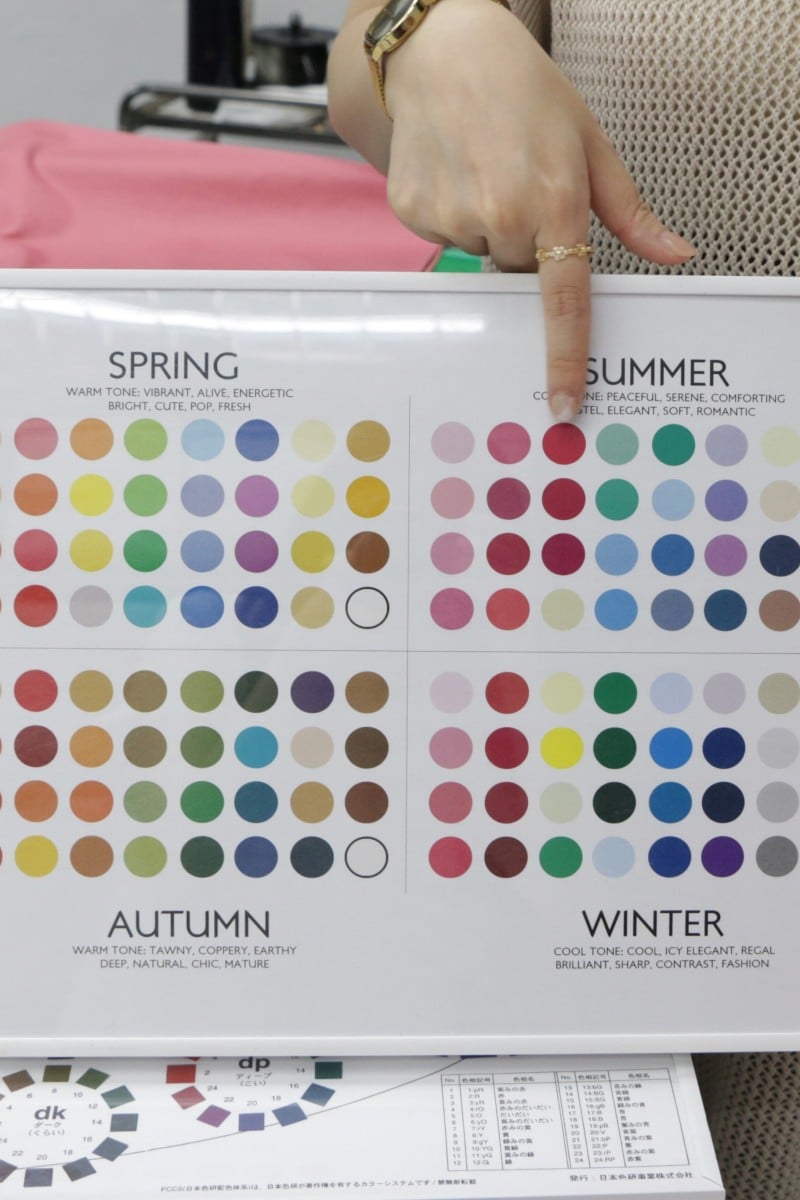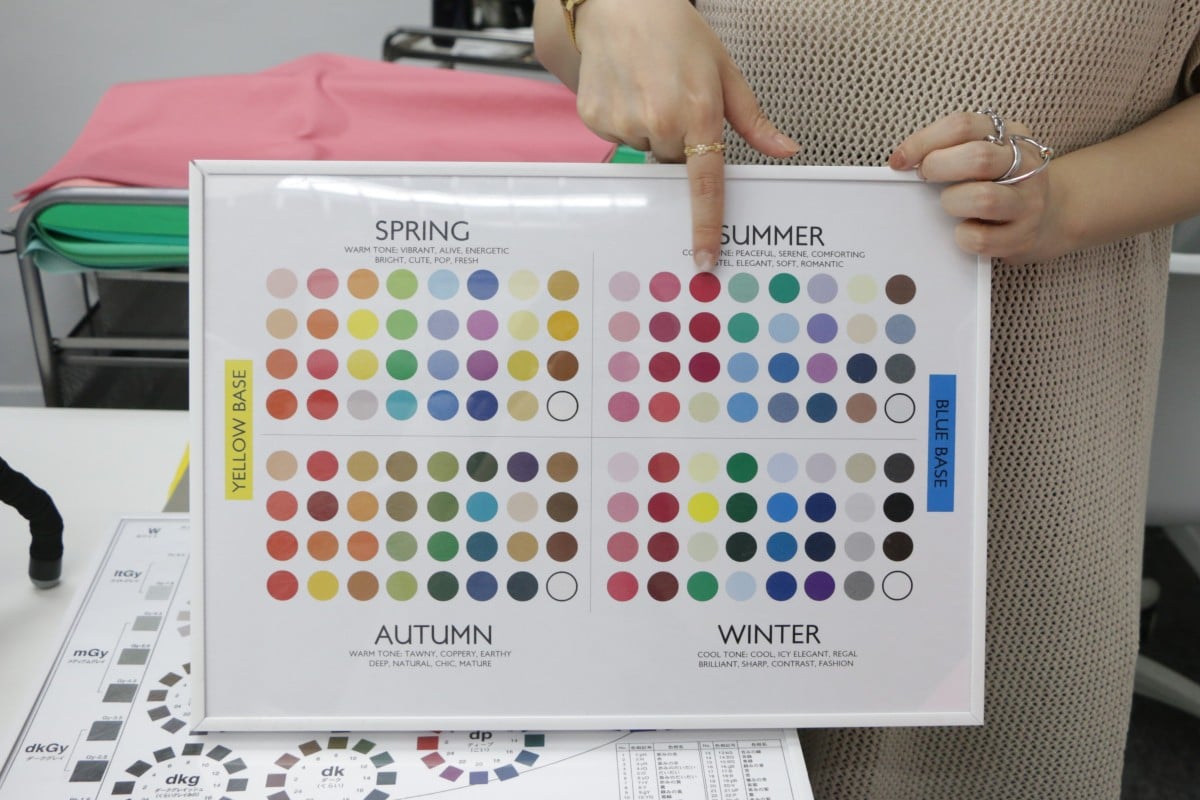
Study Buddy (Explorer): Blackpink’s Jisoo is ‘dark winter’ – how personal colour analysis can find your best hues
- These analysts use colour theory to help people find the best shades to wear based on their skin tone, and it is quickly becoming popular in Asia
- Each week, this page presents an interesting story that we have adjusted to be more accessible for all English learners
 Carrie Kwok, a colour analyst, explains the categories of personal colour according to the different seasons.
Photo: Rachel Yeo
Carrie Kwok, a colour analyst, explains the categories of personal colour according to the different seasons.
Photo: Rachel YeoContent provided by British Council
Read the following text, and answer questions 1-9 below:
[1] Personal colour analysis uses colour theory to help people find the best colours to wear. It is quickly becoming popular in Asia. The results are based on the tone of a person’s skin and the four seasons.
[2] It all started with Hyeri, a member of the K-pop group Girl’s Day. In 2020, she posted a YouTube video of herself getting a colour analysis consultation. In April 2022, one of these appointments was featured on Korean game show Running Man. Blackpink member Jisoo recently got an analysis and found her colours are “dark winter”.
[3] Colour analysis has made its way to Hong Kong, according to Carrie Kwok Ka-lee. Kwok is in her thirties and is among a dozen consultants in the city that provide this service. In August 2022, the fashion designer switched to personal colour analysis full time to cope with the rising demand. She is fully booked for the next few months.
[4] A consultation that lasts for 90 minutes can range from HK$500 to HK$1,000. The price depends on the studio’s location and how many details the consultant gives during the session and in the final report.
[5] The Japan Personal Colour Association is where Kwok got her certification in 2020. The institution is one of the few around the world that trains personal colour analysts. Assigning clothing colours to one of the four seasons is a long-standing practice, but personal colour analysis sorts people into 12 categories. Each category has its “best” palette and hues.
[6] The 12 groups are bright winter, true winter, dark winter, dark autumn, true autumn, soft autumn, soft summer, true summer, light summer, light spring, true spring and bright spring. Winter and summer are considered cool tones, while spring and autumn are warm tones. Warm tones have a yellow base, while cool tones have a blue base.
[7] Analysts hold a piece of fabric next to their client’s face to determine if the colour affects how they look. For example, they will see if it darkens the area under their eyes, makes their skin look unhealthy, brings out redness, washes out their complexion, helps define their jawline, and other things.
[8] A personal colour test can help someone know what shades they look best in. But Kwok said the results should be seen as guidelines, not restrictions: “In your personal time, you can still wear what you like, or colours that are not best for you.”
[9] “For example, many people like wearing black, but it might not suit everyone. But when you have a special occasion – say an interview, a presentation or a meeting with clients – you know what to wear so you can look sharper.”
Source: South China Morning Post, May 25
Questions
1. What does personal colour analysis do according to paragraph 1?
2. In paragraph 2, what was the result of Hyeri’s colour analysis?
A. dark winter
B. true autumn
C. soft summer
D. information not given
3. According to paragraph 3, Carrie Kwok Ka-lee became a full-time personal colour analyst because ...
A. there was a huge demand for this service.
B. she gets to meet K-pop celebrities.
C. she became bored of being a fashion designer.
D. this field pays her more.
4. What is the minimum fee that clients would have to pay for a 90-minute consultation based on paragraph 4?
5. Decide whether the following statements are True, False or the information is Not Given in paragraphs 5 and 6. Fill in ONE circle only for each statement. (4 marks)
(i) Kwok is a certified personal colour analyst.
(ii) Individuals can be classified into four main categories through personal colour analysis.
(iii) Most people belong to the “dark winter” group.
(iv) Autumn and spring are examples of cool tones.
6. Find a word in paragraph 6 that refers to “the brightness, deepness or shade of a colour”.
7. How are warm tones different to cool tones?
8. In paragraph 7, what do analysts do to find out which category someone belongs to?
9. Does Kwok recommend her clients to only wear what they look best in, and why?
Answers
1. It uses colour theory to help people find the best colours to wear.
2. D
3. A
4. HK$500
5. (i) T; (ii) F; (iii) NG; (iv) F
6. tones
7. Warm tones have a yellow base, while cool tones have a blue base.
8. Analysts hold a piece of fabric next to their client’s face.
9. No, because they can still wear what they like in their personal time. / No, because the personal colour test should be seen as guidelines, not restrictions. (any one)
